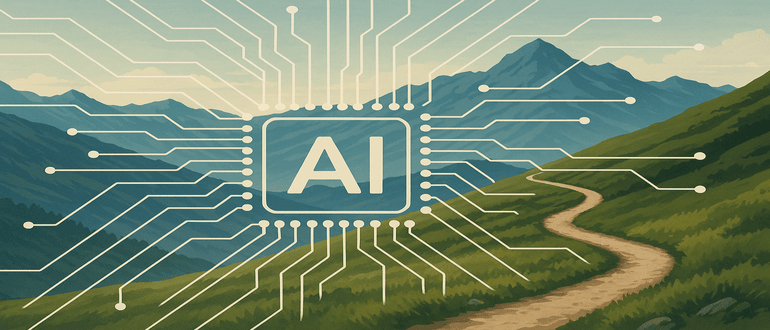
I was on a webinar the other day, and the speaker — clearly trying to stay ahead of the AI hype curve — declared that we’re now past the era of generative AI. According to him, that ship has sailed. The real game now? Agentic AI.
I couldn’t help but shake my head. Wait a second — bye-bye, generative AI? We hardly knew ya.
It feels like just yesterday we were marveling at the almost auto-magical way ChatGPT was finishing our sentences, the way Midjourney could render masterpieces in seconds, and everyone and their uncle was spinning up “AI-powered” everything. Billions of dollars poured in, job descriptions changed overnight, and companies scrambled to ride the AI wave before it crashed over them.
But now we’re being told: “That was the warm-up act. Get ready for the real headliner — agentic AI.”
And yet, despite all the noise, money and ambition, I’ve got to ask: Have we already hit peak AI? Or maybe, more accurately: Have we hit a plateau?
From Fast Climb to Flattening Out
Let’s be clear: AI isn’t dead, dying, or even declining. But it does seem like the breathless pace of progress we saw over the past two years is starting to level off.
There’s some smoke here — and maybe even a little fire.
Take the recent Futurism article that caught my eye. It highlights growing concern among AI scientists that we’re entering a plateau in capabilities. Progress isn’t stalling completely, but the leaps are getting smaller, the breakthroughs less dramatic, and the “wow” factor is fading.
I’ve seen it myself. Talk to folks working with these agentic systems — the ones that are supposed to be autonomous, persistent, and proactive — and you’ll hear a familiar refrain: “It still takes just as much work to get results as doing it myself.”
In other words, we’re building smarter tools, sure — but we’re not quite building dependable colleagues. Not yet.
It was Inevitable, Really
Should we be surprised? I’m not.
We’ve been here before. This is textbook Gartner Hype Cycle stuff.
Every new wave of tech follows a similar arc: Explosive hype, inflated expectations, early adoption, then a reality check. The trough of disillusionment is real — and it’s often where the actual work begins.
Think about it: The kinds of tasks we’re now expecting AI to perform — context switching, long-term reasoning, adaptability across domains — these are hard. Like, really hard. And the more we push AI toward autonomy, the more brittle it gets.
Frankly, it’s amazing we’ve come this far this fast. But the speed of progress was never sustainable. At some point, the rocket boosters run out, and we have to start climbing the rest of the hill the hard way.
Could Another Breakthrough be Around the Corner?
That said, we shouldn’t confuse a slowdown with a dead end.
The history of innovation is full of plateaus — followed by step changes that reignite growth.
So what might spark the next leap in AI?
- Neuro-symbolic AI is one promising frontier — combining the pattern recognition of neural nets with the logical reasoning of symbolic systems. Translation: fewer hallucinations, more real thinking. Amazon’s already experimenting here, and the potential is exciting.
- We’re also seeing advances in causal AI — models that can understand cause and effect, not just correlation. That’s a huge step forward if we want machines that don’t just react, but can actually reason.
- On the hardware side, breakthroughs like IBM’s NorthPole chip — which mimics the brain’s structure to drastically improve efficiency — could reshape the performance curve.
- And let’s not forget multi-modal AI — systems that can simultaneously process and integrate text, images, audio and more. These models may be the key to building AI agents that understand the world more like we do.
Any of these, or a combination of them, could jumpstart the next exponential curve. But let’s be honest — it’s anyone’s guess when or if that will happen.
Meanwhile, There’s Plenty to Work With
Here’s where I land: Whether or not we’ve hit peak AI is almost beside the point.
Because we already have an unprecedented set of tools at our disposal. Generative AI might not be “new” anymore, but it’s still powerful. You don’t need to wait for AGI or some mythical agent to start seeing real ROI.
The use cases are there — content generation, customer support, low-code development, knowledge management, cybersecurity defense — you name it. And most businesses haven’t even scratched the surface yet.
So before we chase the next shiny object, maybe it’s time to focus on applying what we’ve got. Tight integration, smart governance, user training, iterative rollout — these are the difference-makers now.
Final Thought
No, I don’t think we’ve reached the end of the AI road. But we may be taking a breather on a scenic overlook, catching our breath before the next climb. And that’s okay.
Innovation rarely moves in a straight line. It zigzags, it pauses, it surprises. The key is to stay grounded, stay skeptical, but stay moving.
Because while the AI hype machine may be stuck in second gear, the transformation it unlocked is far from over.
There’s still a long way to go — and plenty of mountain left to climb.

